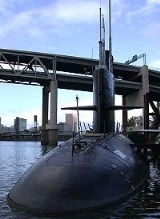
Barbel class submarine
Encyclopedia
The Barbel class of submarines, the last diesel-electric propelled attack submarine
s built by the United States Navy
, incorporated numerous, radical engineering improvements over previous classes. They were the first production warships built with the teardrop-shape hull first tested on Albacore (SS-569)
, and the first to use an "attack center" within the hull rather than a conning tower in the sail. This class of submarine became part of the United States Navy's fleet in 1958 and was taken out of service between 1988 and 1990, leaving the Navy with an entirely nuclear-powered submarine fleet.
The Barbel class' design is considered to be very effective. The Zwaardvis class submarine
of the Netherlands and the Hai Lung class submarine
of the Republic of China
(built and sold by the Netherlands) were based on the Barbel class design.
Submarine
A submarine is a watercraft capable of independent operation below the surface of the water. It differs from a submersible, which has more limited underwater capability...
s built by the United States Navy
United States Navy
The United States Navy is the naval warfare service branch of the United States Armed Forces and one of the seven uniformed services of the United States. The U.S. Navy is the largest in the world; its battle fleet tonnage is greater than that of the next 13 largest navies combined. The U.S...
, incorporated numerous, radical engineering improvements over previous classes. They were the first production warships built with the teardrop-shape hull first tested on Albacore (SS-569)
USS Albacore (AGSS-569)
USS Albacore was a unique research submarine that pioneered the American version of the teardrop hull form of modern submarines. The revolutionary design was derived from extensive hydrodynamic and wind tunnel testing, with an emphasis on underwater speed and maneuverability...
, and the first to use an "attack center" within the hull rather than a conning tower in the sail. This class of submarine became part of the United States Navy's fleet in 1958 and was taken out of service between 1988 and 1990, leaving the Navy with an entirely nuclear-powered submarine fleet.
The Barbel class' design is considered to be very effective. The Zwaardvis class submarine
Zwaardvis class submarine
The Zwaardvis class submarine is a conventional attack submarine that replaced the Dolfijn class in the Royal Netherlands Navy. Zwaardvis is based on the U.S. Navy Barbel class with the teardrop hull design. In September 1981 the Republic of China ordered two modified Zwaardvis class submarines,...
of the Netherlands and the Hai Lung class submarine
Hai Lung class submarine
The Hai Lung class of submarine was manufactured in the Netherlands for the Republic of China and is currently in service with its navy...
of the Republic of China
Republic of China
The Republic of China , commonly known as Taiwan , is a unitary sovereign state located in East Asia. Originally based in mainland China, the Republic of China currently governs the island of Taiwan , which forms over 99% of its current territory, as well as Penghu, Kinmen, Matsu and other minor...
(built and sold by the Netherlands) were based on the Barbel class design.
General characteristics
- Displacement: 1,745 tons light, 2,316 tons full, 2,644 tons submerged
- Length: 66.5 m (218 ft 1 in)
- Beam: 8.8 m (29 ft)
- Draft: 8.9 m (29 ft 3 in)
- Armament: six 21 inch (533 mm) torpedo tubes (bow), with 18 reload torpedoes
- Propulsion: three Fairbanks-MorseFairbanks-MorseFairbanks Morse and Company was a manufacturing company in the late 19th and early 20th century. Originally a weighing scale manufacturer, it later diversified into pumps, engines, windmills, locomotives and industrial supplies until it was merged in 1958...
38d(8 1/8)×10 3150 shp (2.3 MW) diesel engines, two General Electric motors, totaling 4800 shp (3.6 MW) - Speed: 15 knots (28 km/h) surfaced, 12 knots (22 km/h) snorkeling, 25.1 knots (46.5 km/h) on battery for 90 minutes
- Endurance: 1.5 hours at full speed, 102.0 hours at 3 knots (6 km/h)
- Range: 19,000 miles (31,000 km) without refueling
- Depth: 712 ft (217 m)
- Complement: 85 officers and men

